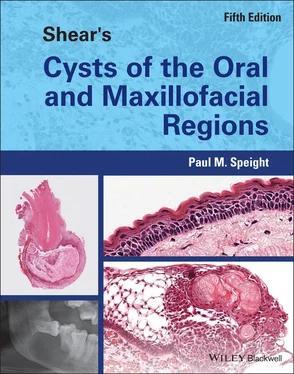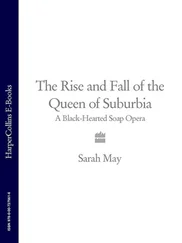Paul M. Speight - Shear's Cysts of the Oral and Maxillofacial Regions
Здесь есть возможность читать онлайн «Paul M. Speight - Shear's Cysts of the Oral and Maxillofacial Regions» — ознакомительный отрывок электронной книги совершенно бесплатно, а после прочтения отрывка купить полную версию. В некоторых случаях можно слушать аудио, скачать через торрент в формате fb2 и присутствует краткое содержание. Жанр: unrecognised, на английском языке. Описание произведения, (предисловие) а так же отзывы посетителей доступны на портале библиотеки ЛибКат.
- Название:Shear's Cysts of the Oral and Maxillofacial Regions
- Автор:
- Жанр:
- Год:неизвестен
- ISBN:нет данных
- Рейтинг книги:5 / 5. Голосов: 1
-
Избранное:Добавить в избранное
- Отзывы:
-
Ваша оценка:
- 100
- 1
- 2
- 3
- 4
- 5
Shear's Cysts of the Oral and Maxillofacial Regions: краткое содержание, описание и аннотация
Предлагаем к чтению аннотацию, описание, краткое содержание или предисловие (зависит от того, что написал сам автор книги «Shear's Cysts of the Oral and Maxillofacial Regions»). Если вы не нашли необходимую информацию о книге — напишите в комментариях, мы постараемся отыскать её.
Shear’s Cysts of the Oral and Maxillofacial Regions
Shear’s Cysts of the Oral and Maxillofacial Regions Fifth Edition
Shear's Cysts of the Oral and Maxillofacial Regions — читать онлайн ознакомительный отрывок
Ниже представлен текст книги, разбитый по страницам. Система сохранения места последней прочитанной страницы, позволяет с удобством читать онлайн бесплатно книгу «Shear's Cysts of the Oral and Maxillofacial Regions», без необходимости каждый раз заново искать на чём Вы остановились. Поставьте закладку, и сможете в любой момент перейти на страницу, на которой закончили чтение.
Интервал:
Закладка:
Immunohistochemistry and Molecular Pathology
There are very many publications reporting the expression of different proteins in odontogenic cysts. In most cases the purpose has been to shed light on the pathogenesis and mechanisms of growth of the lesions, but many papers have attempted to determine whether particular patterns of expression can provide accurate diagnostic markers for each cyst type. Studies of keratin expression and proliferation markers are particularly numerous and the odontogenic keratocyst has been the subject of the majority of studies. Overall, however, immunohistochemistry has only a very small role to play in the diagnosis of cysts of the maxillofacial regions. Although each cyst type may show a different pattern of cytokeratins, the expression demonstrated by immunohistochemistry merely reflects the type of keratinisation that is easily and clearly visible on examination of a routine H&E (haemotoxylin and eosin)‐stained section. The best example of this conundrum is the odontogenic keratocyst. Many studies have been undertaken to compare the cytokeratin profile of keratocysts with other cysts, but almost without exception, the specimens used have been selected as typical histological examples of each cyst type. It is not surprising therefore that if the features are typical, there is no need for any additional staining beyond a good H&E‐stained section to make the diagnosis. One key area of diagnostic difficulty is when the pathologist must examine a small biopsy of an inflamed cyst. When heavily inflamed, any cyst type, including a keratocyst, may become lined by proliferative epithelium identical to that seen in a radicular cyst. The lining becomes non‐keratinised and studies have not been able to identify immunohistochemical markers that can differentiate between an inflammatory cyst and an inflamed developmental cyst. This issue is discussed in detail in Chapter 7. Our experience, supported by a number of studies (Rao et al. 2015 ), suggests that a good H&E‐stained section is the most specific marker for patterns of keratinisation and is usually sufficient to make an accurate diagnosis.
Table 2.3 Characteristic histological features that assist in the diagnosis of cysts of the maxillofacial regions.
| Histological feature | Cyst type(s) | Diagnostic utility | Figure references |
|---|---|---|---|
| Proliferative epithelium with an arcading pattern | Radicular cyst Inflammatory collateral cysts | Typical feature of radicular cyst and of inflammatory collateral cysts But proliferative arcading epithelium may be seen in any odontogenic cyst that is secondarily inflamed | Figures 3.7, 3.12(radicular cyst), 4.7(paradental cyst), 5.22 (dentigerous cyst) |
| The epithelial lining is attached to an unerupted tooth at the cementoenamel junction | Dentigerous cyst | Virtually diagnostic of dentigerous cyst. This feature may be seen on macroscopic examination of an intact specimen or in decalcified sections Note: there have been reports of odontogenic keratocyst or orthokeratinised odontogenic cyst attached at the cementoenamel junction, but this is very rare and is thought to be due to a tooth ‘erupting’ into a cyst (see discussion in Chapter 12) | Figures 5.18 and 5.19 |
| Thin regular parakeratinised epithelium with a corrugated surface and prominent basal layer | Odontogenic keratocyst | Diagnostic of odontogenic keratocyst. This typical epithelium is not seen in any other jaw cyst | Figures 7.15–7.17 |
| Epithelial plaques or thickenings with a whorling pattern | Lateral periodontal cyst Botryoid odontogenic cyst Gingival cyst of adults Glandular odontogenic cyst | Epithelial plaques are seen in all cases of lateral periodontal cyst and are diagnostic if the cyst is unilocular and no other features are noted If the cyst is multilocular, then diagnostic for botryoid odontogenic cyst Gingival cyst shows similar features but is extraosseous Glandular odontogenic cyst may show plaques in about 65% of cases, but must be accompanied by other features (see Table 10.3) | Figures 8.6, 8.7 (lateral periodontal cyst), 8.9 (botryoid odontogenic cyst), 9.4 (Gingival cyst), 10.8 (glandular odontogenic cyst) |
| Cuboidal or columnar cells at the luminal aspect of the cyst lining | Glandular odontogenic cyst | Typical feature and seen in up to 100% of glandular odontogenic cysts. Diagnostic when accompanied by other features (see Table 10.3). Similar cells are occasionally seen in other cyst types, including dentigerous cyst, but these lack other features | Figures 10.7 and 10.8 |
| A simple cyst with ghost cells in the wall | Calcifying odontogenic cyst | This feature is diagnostic of calcifying odontogenic cyst. Note that the lining is ameloblastomatous and if ghost cells are not seen, a diagnosis of cystic ameloblastoma must be considered. Ensure the whole lining is examined (see discussion in Chapter 11). If the lesion is solid, then consider dentinogenic ghost cell tumour. Ghost cells may be seen in odontomas and rarely in ameloblastomas | Figures 11.8–11.10 |
| Hyaline bodies | Various odontogenic cyst types | Hyaline (Rushton) bodies are often stated as being typical of radicular cyst. They are seen in about 10% of radicular cysts, but also in up to 10% of odontogenic keratocysts and dentigerous cysts (see discussion in Chapter 3). However, hyaline bodies are specific and diagnostic of odontogenic cysts | Figures 3.15(radicular cyst), 7.20 (odontogenic keratocyst) |
| Cholesterol clefts | Radicular cyst | Cholesterol clefts result from an accumulation of cholesterol crystals as a results of long‐standing inflammations. They are therefore typical of radicular cyst and are seen in 30% or more of cases ( Table 3.3) But they are not specific and may be seen in any cyst that has become chronically inflamed, in particular in inflamed dentigerous cysts or keratocysts | Figure 3.16 |
| Mucous cells | Various cyst types | Mucous cells have been described in most types of odontogenic cyst and are not diagnostic. They are a result of metaplastic change and are seen in about 20% of radicular cysts, 25% of dentigerous cysts, and 2% of odontogenic keratocysts Note that mucous cells are not a diagnostic requirement for glandular odontogenic cyst and are seen in only about 70% of cases (Table 10.3). Mucous cells are seen in surgical ciliated cysts and in about 50% of nasopalatine duct cysts and nasolabial cysts | Figures 3.14(radicular cyst), 5.23 (dentigerous cyst), 10.10, 10.11 (glandular odontogenic cyst), 13.10 (nasopalatine duct cyst), 14.5 (nasolabial cyst) |
| Sebaceous glands | Dermoid cyst | Sebaceous glands are rare in jaw cysts and when seen a diagnosis of dermoid cyst should be considered. If sweat glands and hair follicles are also present, then this is diagnostic for dermoid cyst. Sebaceous glands have rarely been reported in odontogenic keratocyst and orthokeratinised odontogenic cyst | Figures 18.2 and 18.3 (dermoid cyst) |
| Respiratory epithelium | Nasopalatine duct cyst Various cyst types | Among cysts in the jaws, respiratory epithelium is a typical feature of nasopalatine duct cyst and is seen in about 50% of cases However, this is not specific. Surgical ciliated cyst is lined by respiratory epithelium and metaplastic respiratory epithelium has been described in radicular cysts Among soft tissue cysts, nasolabial cyst, bronchogenic cyst, and thyroglossal duct cyst are lined by respiratory epithelium, and respiratory epithelium may be seen in cysts of foregut or branchial cleft origin ( Boxes 18.2– 18.4) | Figures 3.14(radicular cyst), 13.9 (nasopalatine duct cyst), 14.5 (nasolabial cyst), 16.5 (surgical ciliated cyst), 18.5 (bronchogenic cyst), 18.6 (branchial cyst), 18.8 (thyroglossal duct cyst) |
Despite these limitations, there are a few instances where immunohistochemistry can help establish a diagnosis and differentiate between lesions with similar histological features. A number of diagnostically useful applications are summarised in Table 2.4.
Читать дальшеИнтервал:
Закладка:
Похожие книги на «Shear's Cysts of the Oral and Maxillofacial Regions»
Представляем Вашему вниманию похожие книги на «Shear's Cysts of the Oral and Maxillofacial Regions» списком для выбора. Мы отобрали схожую по названию и смыслу литературу в надежде предоставить читателям больше вариантов отыскать новые, интересные, ещё непрочитанные произведения.
Обсуждение, отзывы о книге «Shear's Cysts of the Oral and Maxillofacial Regions» и просто собственные мнения читателей. Оставьте ваши комментарии, напишите, что Вы думаете о произведении, его смысле или главных героях. Укажите что конкретно понравилось, а что нет, и почему Вы так считаете.












